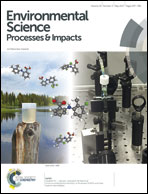Redox and catalytic properties of biochar-coated zero-valent iron for the removal of nitro explosives and halogenated phenols†
Abstract
A novel biochar-coated zero-valent iron [Fe(0)], which was synthesized with rice straw and Fe(0), was applied to remove nitro explosives (2,4,6-trinitrotoluene and hexahydro-1,3,5-trinitro-1,3,5-triazine) and halogenated phenols (2,4-dibromophenol and 2,4-difluorophenol) from contaminated waters. Due to the presence of biochar on the outside, the removal of nitro explosives and halogenated phenols was significantly enhanced via sorption. The sorbed contaminants were further transformed into reductive products, indicating that the inner Fe(0) played the role of a reductant in the biochar-coated Fe(0). Compared to direct reduction with Fe(0), the reductive transformation with biochar-coated Fe(0) was markedly enhanced, suggesting that the biochar in biochar-coated Fe(0) may act as an electron transfer mediator. Further experiments showed that the surface functional groups of biochar were involved in the catalytic enhancement of electron transfer. Our results suggested that biomass could be used to synthesize a novel sorbent and catalyst for treating redox-sensitive contaminants in natural and engineered systems.



 Please wait while we load your content...
Please wait while we load your content...